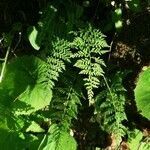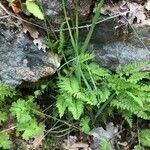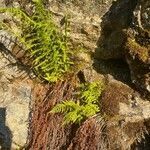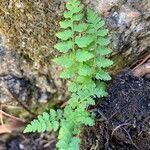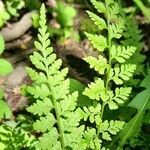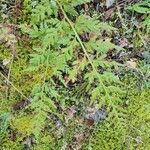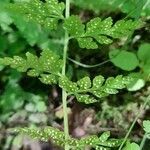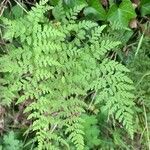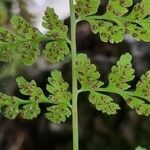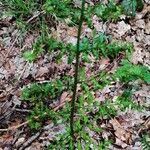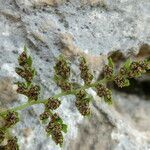Rhizome decumbent, branched, up to 65 mm long, up to 4 mm in diam., with persistent trophopodia up to 7 mm long, and scales; scales ferruginous, narrowly-lanceolate, up to 5 x 0.8 mm. Fronds closely spaced, erect. Stipe ferruginous at base, stramineous higher up, fragile, adaxially sulcate higher up, up to 255 mm long, up to 2 mm in diam., with few-celled uniseriate hairs up to 3 mm long, and oblong to filiform scales near base. Lamina lanceolate, up to 255 x 145 mm, up to 3-pinnate. Rachis stramineous, green towards apex, adaxially sulcate in basal part, distally ridged and narrowly winged, variously set with hairs similar to those on stipe. Pinnae glabrous, basal 1 or 2 pinna pairs reduced or not, up to 2-pinnate, lanceolate to ovate, up to 85 x 45 mm. Pinnules pale green, thinly herbaceous, ovate to lanceolate, up to 28 x 18 mm, somewhat acroscopically developed, up to 1-pinnate; segments elliptic to oblong, up to 8 x 6 mm, lobed; lobes acute to emarginated, glabrous adaxially, often with few oblong unicellular hairs along veins and pinnule margins; venation free, evident. Sori circular, up to 1.2 mm in diam., receptacle elevated. Indusium hyaline, elliptic, clasping receptacle base, with oblong unicellular glands along margin.
Rhizome rather stout to slender, shortly creeping, us. with ascending branches; clad in pale brown to reddish ovate-to lanceolate-attenuate paleae, c. 2-5 mm. long; stipites clustered at tips of branches. Stipes slender to filiform, 2-15-(20) cm. long, stramineous to rather dark brown, shining, nude except at very base. Rhachis very slender, naked, narrowly winged in upper part. Lamina delicate, flaccid, pale green, narrow-lanceolate to ovate-lanceolate, pinnate to subbipinnate, 3-25 × 1-5 cm., often bearing sori in smallest state. Pinnae distant, alt. to subopp., lower shortly stalked, upper sessile and decurrent, 5 mm.-4 cm. × 4-15 mm. Shape various: ovate, pinnatifid, lobes crenately toothed to entire; ovate-to lanceolate-oblong, pinnatisect, lobes crenately toothed; ovate-oblong, again pinnate in lower, pinnatifid in upper portion, crenate-dentate, with secondary pinnae ovate-oblong up to 1 × 1cm., cuneately narrowed at base, lobes sts incised. Sori medial, 1-4 per lobe, 1-2 mm. diam., sts approximate to confluent. Indusium caducous, ovate, entire to ovate-oblong, shallowly toothed to subentire.
Stems creeping, not cordlike, internodes short, beset with old petiole bases, hairs absent; scales tan to light brown, lanceolate, radial walls thin, luminae tan. Leaves monomorphic, clustered at stem apex, to 40 cm, nearly all bearing sori. Petiole dark at base, mostly green to straw-colored distally, shorter than or nearly equaling blade, base sparsely scaly. Blade lanceolate to narrowly elliptic, 1(--2)-pinnate-pinnatifid, widest at or just below middle, apex acute; rachis and costae lacking gland-tipped hairs or bulblets; axils of pinnae lacking multicellular, gland-tipped hairs. Pinnae usually perpendicular to rachis, not curving toward blade apex, margins serrate to sharply dentate; proximal pinnae pinnatifid to pinnate-pinnatifid, ± equilateral, basiscopic pinnules not enlarged; basal basiscopic pinnules sessile, base truncate to obtuse, distal pinnae deltate to ovate. Veins directed mostly into teeth. Indusia ovate to lanceolate, without gland-tipped hairs. Spores spiny or verrucate, usually 39--60 µm. 2 n = 168, 252.
Lvs glabrous or inconspicuously glandular, in a small cluster on a short, densely scaly rhizome, 0.5–3.5(–4) dm, the dark brown (or distally greenish) petiole shorter than or to as long as the blade; blade mostly 3.5–20(–25) × 1.5–8 cm, (2–)2.5–4(–5) times as long as wide, 2–3 times pinnate, with 8–18 pairs of pinnae (the members of a pair often offset, especially the distal pairs), the lowest pair equaling or generally a little smaller than the next pair, the upper ones gradually reduced so that the blade tapers into a narrow tip; veins typically directed to the teeth of the pinnules, but the tooth sometimes apically slightly indented so that the vein ends in a small sinus; indusium pale, not glandular; 2n=188 in ours. Moist, mostly wooded slopes and ledges in circumneutral soil; circumboreal, s. in our range to Va. and Mo. We have 2 vars. with widely overlapping distribution:
Rhizomes short, horizontal, scaly. Stipes 5-15 cm long, dark brown and scaly at base, straw-coloured and ± glabrous above. Laminae narrowly ovate, ovate or narrowly triangular, 10-30 × 6-14 cm, 2-3-pinnate at base, glabrous. Primary pinnae in 15-25 pairs, ovate to ± triangular, tapering at apices, the longest 3-8 × 1.5-4 cm. Secondary pinnae in 5-12 pairs, ovate to ± oblong, acute, to 2 × 1 cm, those on upper primary pinnae bluntly toothed, those on basal primary pinnae deeply incised or divided into tertiary pinnae. Sori rounded, protected by ovate indusia arching over sporangia.
Rhizome c. 2 mm in diameter, set with pale to reddish brown, subentire, lanceolate, thin rhizome-scales up to 3 x 0.6 mm. Fronds closely spaced, thinly herbaceous; stipe stramineous, sparsely scaly, becoming brown and set with broader scales basally, up to 90 mm long; lamina ovate to oblong-lanceolate, up to 150 x 50 mm, basal pinnae reduced, 3-to 4-pinnatifid (2-pinnatifid in young plants), lamina narrowly winging costules; ultimate lobes obtusely dentate (occasionally acute). Sori c. 0.5 mm in diameter, opening towards margin; indusia dentate to lacerate.
Rhizome shortly creeping, dictyostelic, set with lanceolate brown rhizome scales. Stipe stramineous to castaneous. Lamina herbaceous, 2-to 4-pinnatifid, glabrous, veins free. Sori dorsal on veins, round, without paraphyses. Indusia peltate. Spores reniform, smooth.
Rhizomatous perennial. Fronds erect, to 30 cm long, stipe sparsely scaled, lamina thinly herbaceous, oblong-lanceolate, 3-or 4-pinnatifid, to 15 cm long, ultimate segments obtusely dentate. Sori circular, indusium at receptacle base scale-like, lacerate.
A fern. It grows 20-25 cm high. It forms clumps. The brown rootstock is covered with broad brown scales. The fronds occur in tufts and are grey-green. They are lacy and divided once. The segments have irregular lobes and teeth along the edge.
